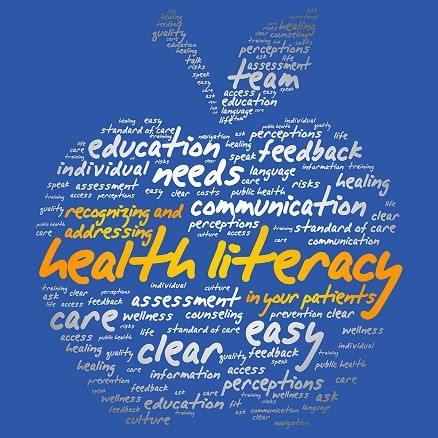Health Literate Apps
Software Column
by Allen McLean, RN, MN, MSc, PhD(c)
Allen is currently a PhD Candidate in Health Sciences at the University of Saskatchewan (Saskatoon) in the Computational Epidemiology and Public Health Informatics Lab. His research interests include the development of computer modeling and simulation software for addressing health systems challenges, chronic diseases and health inequities at the population level, as well as mobile technologies applied in long-term care facilities. Allen previously attended the University of Victoria earning an MN and MSc (Health Information Science) in a unique dual degree program for Nursing Informatics professionals. Allen has over 20 years’ experience in healthcare as an ultrasound technologist, clinical educator, team leader and community health RN.
Citation: McLean, A. (2021). Health Literate Apps. Software Column. Canadian Journal of Nursing Informatics, 16(2). https://cjni.net/journal/?p=9060
COLUMN

There are literally tens of thousands of health and medical apps available for download. Some of these apps have been developed to a high standard, but too many have not. An area of app development that rarely receives much attention is health literacy, and nurses are well situated to make important contributions in this sub-area of the user-experience design process. As more and more people access and use mHealth apps, the need to integrate health literacy into the development of mHealth apps becomes more and more important. One way to maximize the potential of mHealth apps for improving health is to ensure that these apps are designed to deliver health information that is simple, engaging, and easy to use for people of all literacy levels. Worse, if mobile apps are poorly designed, they may even contribute to the challenges many users face when trying to understand and act on health information—challenges that are exacerbated for users with low health literacy.
The concept of health literacy continues to evolve, as do the numerous definitions. Early definitions focused on health education and literacy skills such as reading, writing, and numeracy. Health literacy is now understood as a broader construct, often referred to as multidimensional health literacy. An influential conceptualization and definition from Sørensen et al. (2012) identifies key individual and population level competencies for accessing, understanding, appraising, and applying health-related information. These competencies go far beyond literacy and include knowledge, motivation, personal and situational determinants, participation, competence, equity, empowerment, sustainability, and costs, among others. “Health literacy is linked to literacy and entails people’s knowledge, motivation and competences to access, understand, appraise, and apply health information in order to make judgments and make decisions in everyday life concerning healthcare, disease prevention and health promotion to maintain or improve quality of life during the life course” (Sørensen et al., 2012, p. 3). Accepting this understanding of health literacy means developers must make an extra effort to get to know their users, and to build ‘health literate apps’ – apps that apply both usability and health literacy strategies throughout the development process.
Broderick et al. (2014) have written about this problem, its importance (also Berkman et al., 2011), and discussed usability strategies to address the lack of health literacy concepts in the app development process (Table 1).
Table 1: Usability Strategies to address Lack of Health Literacy
| Strategies | Actions |
|---|---|
| Learn About Your Users | Identify your users. Who are they? What are they trying to do? And why? Engage users in the design process (co-design). |
| Write Actionable Content | Put the most important information first. Describe the health behaviour – just the basics. Stay positive and realistic. Include the benefits of taking action. Provide specific action steps. Write in plain language! |
| Display Content Clearly | Limit paragraph size. Use bullets and short lists. Use meaningful headings. Use a familiar font in at least 12-point type. Use white space and avoid clutter. Keep content in the centre of the screen. Label links clearly. Use images that facilitate learning. Use bold colours with contrast. Avoid dark backgrounds. Make your site accessible to people with disabilities. |
| Organize and Simplify | Create a simple and engaging home page. Use labels that reflect words your users know. Enable easy access to home and menu pages. Make sure the “back” button works. Use linear information paths. Include simple search and browse options. Integrate with other apps, including e-mail, calendar, and maps/global positioning system (GPS), based on users’ feedback. |
| Engage Users | Include printer-friendly tools and resources. Simplify screen-based controls and enlarge buttons. Include interactive content that users can tailor. Incorporate audio and visual features. Explore new media such as Twitter or text messaging. |
| Evaluate and Revise Your Site | Recruit users with limited health literacy skills. Choose experienced moderators. Test comprehension in multiple ways. Consider user engagement and self-efficacy. Create plain-language testing documents. |
References
Berkman, N. D., Sheridan, S. L., Donahue, K. E., Halpern, D. J., & Crotty, K. (2011). Low health literacy and health outcomes: An updated systematic review. Annals of Internal Medicine, 155(2), 97-107. https://doi.org/10.7326/0003-4819-155-2-201107190-00005
Broderick, J., Devine, T., Langhans, E., Lemerise, A. J., Lier, S., & Harris, L. (2014). Designing health literate mobile apps. NAM Perspectives. https://health.gov/sites/default/files/2019-11/BPH-HealthLiterateApps_0.pdf
Sørensen, K., Van den Broucke, S., Fullam, J., Doyle, G., Pelikan, J., Slonska, Z., Brand, H. (2012). Health literacy and public health: A systematic review and integration of definitions and models. BMC Public Health, 12(1), 80. https://doi.org/10.1186/1471-2458-12-80






